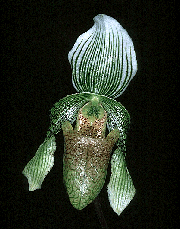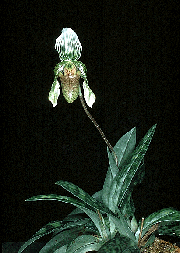|
@Paph. parnatanum was registered as a new species of Paphiopedilum
by IAPT in February, before P. usitanum described by O. Gruss.
This was published in the French Review named Orchidees, Culture
et protection, NĄ38, 1999. This species is similar to P. argus,
P. wardii and P. sukhakulii concerning the form, the color of
the flower and the leaves. The upper surface of the leaves is
green mottled with gray: 8-20cm long and 1.8-3.5cm large. The.surface
below is plain green. The inflorescence, 18-20cm long, has only
one.flower. The flower is 7.5-8cm large.The dorsal sepal is white
striated with.green ; petals are light green and mottled with
brown ; lip is deep to light.brown with deeper reticulation on
the central lobe ; lateral lobes have the same color as the central
lobe. Staminod is light green. The dorsal sepal is ovate, acuminate,
3-3.2cm long and 2.9-3cm large. Petals are pendulous, slightly
spatulate, undulated at apex, ciliate at the base, 4.5-4.6cm
long and 1.3-1.4cm large. The lip is trilobate, 4.1-4.2cm long
and 2.2-2.4cm large. The lateral lobes are verrucose and folded
at the base of the staminod. The staminod is ovate, 0,7-0,9cm
long and 0,9-1cm large. I think that this new Paphiopedilum is
very close to P. sukhakulii and P. wardii in the form and the
color of the petals. But it differs from these two species in
the dimension, and completely ciliated staminod, and also by
the color of the lip and very developed lateral lobes folded
at the base of the staminod ( by Mr. William Cavestro ).
|

